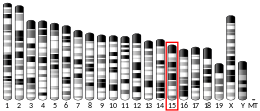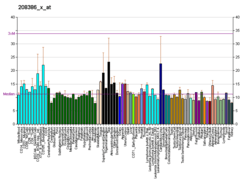DMC1 (gene)
Meiotic recombination protein DMC1/LIM15 homolog is a protein that in humans is encoded by the DMC1 gene.[5][6][7][8]
Meiotic recombination protein Dmc1 is a homolog of the bacterial strand exchange protein RecA. Dmc1 plays the central role in homologous recombination in meiosis by assembling at the sites of programmed DNA double strand breaks and carrying out a search for allelic DNA sequences located on homologous chromatids. The name "Dmc" stands for "disrupted meiotic cDNA" and refers to the method used for its discovery which involved using clones from a meiosis-specific cDNA library to direct knock-out mutations of abundantly expressed meiotic genes. The Dmc1 protein is one of two homologs of RecA found in eukaryotic cells, the other being Rad51. In budding yeast, Rad51 serves as a strand exchange protein in mitosis where it is critical for the repair of DNA breaks. Rad51 is converted to an accessory factor for Dmc1 during meiosis by inhibition of its strand exchange activity.[9] Homologs of DMC1 have been identified in many organisms including divergent fungi, plants and mammals including humans.[5][6][7][8]
Discovery
The DMC1 gene and protein were discovered in the budding yeast S. cerevisiae by Douglas Bishop when he was a postdoctoral fellow in the laboratory of Nancy Kleckner at Harvard University.[10]
Function
The protein encoded by this gene is essential for meiotic homologous recombination. Genetic recombination in meiosis plays an important role in generating diversity of genetic information and facilitates the reductional segregation of chromosomes that must occur for formation of gametes during sexual reproduction.
Like other members of the Rad51/RecA family, Dmc1 stabilizes strand exchange intermediates (Rad1/RecA-stretched DNA, or RS-DNA) in stretched triplets similar to B form DNA. Each molecule of the protein binds a triplet of nucleotides, and the strength of that binding, as assessed by the change in Gibbs free energy, can be assessed by the length of time that a labelled dsDNA probe with a short homologous sequence remains bound to a DNA containing a short region of homology to it. A study of this type has shown that a mismatch in any of the three positions at the end of a stretch of homology will not increase the length of time that the probe remains bound, and in Rad51 or RecA constructs an internal mismatch will cause a similar reduction in binding time. All of the enzymes are capable of "stepping over" a mismatch and continuing to bind the probe more firmly if a longer region of homology exists. However, with Dmc1 a triplet with a single internal (but not terminal) mismatch will contribute to the stability of probe binding to a similar extent as one without a mismatch. In this way, Dmc1 is specially suited to its role as a meiosis-specific recombinase, as this activity permits it more effectively to catalyze recombination between sequences that are not perfectly matched.[11]
Interactions
DMC1 (gene) has been shown to interact with RAD51.[12] The protein has also been shown to bind Tid1(Rdh54), Mei5/Sae3, and Hop2/Mnd1. All of these interacting proteins act to enhance Dmc1's activity in purified systems and are also implicated as being required for Dmc1 function in cells.
Rad51 interaction with Dmc1
During meiosis, the two recombinases, Rad51 and Dmc1, interact with single-stranded DNA to form specialized filaments that are adapted for facilitating recombination between homologous chromosomes. Both Dmc1 and Rad51 have an intrinsic ability to self-aggregate.[13] The presence of Rad51 filaments stabilizes adjacent Dmc1 filaments and conversely Dmc1 stabilizes adjacent Rad51 filaments. A model was proposed in which Dmc1 and Rad51 form separate filaments on the same single stranded DNA and cross-talk between the two recombinases affects their biochemical properties.[13]
During meiosis, even in the absence of Rad51 strand exchange activity, Dmc1 appears to be able to repair all meiotic DNA breaks, and this absence does not affect meiotic crossing over rates.[14]
References
- GRCh38: Ensembl release 89: ENSG00000100206 - Ensembl, May 2017
- GRCm38: Ensembl release 89: ENSMUSG00000022429 - Ensembl, May 2017
- "Human PubMed Reference:". National Center for Biotechnology Information, U.S. National Library of Medicine.
- "Mouse PubMed Reference:". National Center for Biotechnology Information, U.S. National Library of Medicine.
- Habu T, Taki T, West A, Nishimune Y, Morita T (1996). "The mouse and human homologs of DMC1, the yeast meiosis-specific homologous recombination gene, have a common unique form of exon-skipped transcript in meiosis". Nucleic Acids Res. 24 (3): 470–7. doi:10.1093/nar/24.3.470. PMC 145652. PMID 8602360.
- Sato S, Seki N, Hotta Y, Tabata S (1995). "Expression profiles of a human gene identified as a structural homologue of meiosis-specific recA-like genes". DNA Res. 2 (4): 183–6. doi:10.1093/dnares/2.4.183. PMID 8590282.
- Thorslund T, Esashi F, West SC (2007). "Interactions between human BRCA2 protein and the meiosis-specific recombinase DMC1". EMBO J. 26 (12): 2915–22. doi:10.1038/sj.emboj.7601739. PMC 1894777. PMID 17541404.
- "Entrez Gene: DMC1 DMC1 dosage suppressor of mck1 homolog, meiosis-specific homologous recombination (yeast)".
- Cloud V, Chan YL, Grubb J, Budke B, Bishop DK (2012). "Rad51 is an accessory factor for Dmc1-mediated joint molecule formation during meiosis". Science. 337 (6099): 1222–5. doi:10.1126/science.1219379. PMC 4056682. PMID 22955832.
- Bishop DK, Park D, Xu L, Kleckner N (1992). "DMC1: a meiosis-specific yeast homolog of E. coli recA required for recombination, synaptonemal complex formation, and cell cycle progression". Cell. 69 (3): 439–56. doi:10.1016/0092-8674(92)90446-j. PMID 1581960.
- Lee JY, Terakawa T, Qi Z, Steinfeld JB, Redding S, Kwon Y, Gaines WA, Zhao W, Sung P, Greene EC (Aug 2015). "DNA recombination. Base triplet stepping by the Rad51/RecA family of recombinases". Science. 349 (6251): 977–81. doi:10.1126/science.aab2666. PMC 4580133. PMID 26315438.
- Masson JY, Davies AA, Hajibagheri N, Van Dyck E, Benson FE, Stasiak AZ, Stasiak A, West SC (Nov 1999). "The meiosis-specific recombinase hDmc1 forms ring structures and interacts with hRad51". EMBO J. 18 (22): 6552–60. doi:10.1093/emboj/18.22.6552. PMC 1171718. PMID 10562567.
- Crickard JB, Kaniecki K, Kwon Y, Sung P, Greene EC (2018). "Spontaneous self-segregation of Rad51 and Dmc1 DNA recombinases within mixed recombinase filaments". J. Biol. Chem. 293: 4191–4200. doi:10.1074/jbc.RA117.001143. PMC 5858004. PMID 29382724.
- Singh G, Da Ines O, Gallego ME, White CI (2017). "Analysis of the impact of the absence of RAD51 strand exchange activity in Arabidopsis meiosis". PLoS ONE. 12 (8): e0183006. doi:10.1371/journal.pone.0183006. PMC 5552350. PMID 28797117.
Further reading
- Golub EI, Gupta RC, Haaf T, Wold MS, Radding CM (1998). "Interaction of human rad51 recombination protein with single-stranded DNA binding protein, RPA". Nucleic Acids Res. 26 (23): 5388–93. doi:10.1093/nar/26.23.5388. PMC 148005. PMID 9826763.
- Masson JY, Davies AA, Hajibagheri N, Van Dyck E, Benson FE, Stasiak AZ, Stasiak A, West SC (1999). "The meiosis-specific recombinase hDmc1 forms ring structures and interacts with hRad51". EMBO J. 18 (22): 6552–60. doi:10.1093/emboj/18.22.6552. PMC 1171718. PMID 10562567.
- Dunham I, Shimizu N, Roe BA, Chissoe S, Hunt AR, Collins JE, Bruskiewich R, Beare DM, Clamp M, Smink LJ, Ainscough R, Almeida JP, Babbage A, Bagguley C, Bailey J, Barlow K, Bates KN, Beasley O, Bird CP, Blakey S, Bridgeman AM, Buck D, Burgess J, Burrill WD, O'Brien KP (1999). "The DNA sequence of human chromosome 22". Nature. 402 (6761): 489–95. doi:10.1038/990031. PMID 10591208.
- Moens PB, Kolas NK, Tarsounas M, Marcon E, Cohen PE, Spyropoulos B (2002). "The time course and chromosomal localization of recombination-related proteins at meiosis in the mouse are compatible with models that can resolve the early DNA-DNA interactions without reciprocal recombination". J. Cell Sci. 115 (Pt 8): 1611–22. PMID 11950880.
- Habu T, Wakabayashi N, Yoshida K, Yomogida K, Nishimune Y, Morita T (2004). "p53 Protein interacts specifically with the meiosis-specific mammalian RecA-like protein DMC1 in meiosis". Carcinogenesis. 25 (6): 889–93. doi:10.1093/carcin/bgh099. PMID 14764457.
- Kinebuchi T, Kagawa W, Enomoto R, Tanaka K, Miyagawa K, Shibata T, Kurumizaka H, Yokoyama S (2004). "Structural basis for octameric ring formation and DNA interaction of the human homologous-pairing protein Dmc1". Mol. Cell. 14 (3): 363–74. doi:10.1016/S1097-2765(04)00218-7. PMID 15125839.
- Sehorn MG, Sigurdsson S, Bussen W, Unger VM, Sung P (2004). "Human meiotic recombinase Dmc1 promotes ATP-dependent homologous DNA strand exchange". Nature. 429 (6990): 433–7. doi:10.1038/nature02563. PMID 15164066.
- Collins JE, Wright CL, Edwards CA, Davis MP, Grinham JA, Cole CG, Goward ME, Aguado B, Mallya M, Mokrab Y, Huckle EJ, Beare DM, Dunham I (2004). "A genome annotation-driven approach to cloning the human ORFeome". Genome Biol. 5 (10): R84. doi:10.1186/gb-2004-5-10-r84. PMC 545604. PMID 15461802.
- Kinebuchi T, Kagawa W, Kurumizaka H, Yokoyama S (2005). "Role of the N-terminal domain of the human DMC1 protein in octamer formation and DNA binding". J. Biol. Chem. 280 (31): 28382–7. doi:10.1074/jbc.M503372200. PMID 15917243.
- Bugreev DV, Golub EI, Stasiak AZ, Stasiak A, Mazin AV (2005). "Activation of human meiosis-specific recombinase Dmc1 by Ca2+". J. Biol. Chem. 280 (29): 26886–95. doi:10.1074/jbc.M502248200. PMID 15917244.
- Rual JF, Venkatesan K, Hao T, Hirozane-Kishikawa T, Dricot A, Li N, Berriz GF, Gibbons FD, Dreze M, Ayivi-Guedehoussou N, Klitgord N, Simon C, Boxem M, Milstein S, Rosenberg J, Goldberg DS, Zhang LV, Wong SL, Franklin G, Li S, Albala JS, Lim J, Fraughton C, Llamosas E, Cevik S, Bex C, Lamesch P, Sikorski RS, Vandenhaute J, Zoghbi HY, Smolyar A, Bosak S, Sequerra R, Doucette-Stamm L, Cusick ME, Hill DE, Roth FP, Vidal M (2005). "Towards a proteome-scale map of the human protein-protein interaction network". Nature. 437 (7062): 1173–8. doi:10.1038/nature04209. PMID 16189514.
- Pezza RJ, Voloshin ON, Vanevski F, Camerini-Otero RD (2007). "Hop2/Mnd1 acts on two critical steps in Dmc1-promoted homologous pairing". Genes Dev. 21 (14): 1758–66. doi:10.1101/gad.1562907. PMC 1920170. PMID 17639081.







